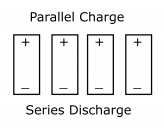Can cells be charged this way?
 lardom
Posts: 1,659
lardom
Posts: 1,659
Every balance charging connector I've seen has multiple pins. The only advantage I can see for multiple pins is speed of charging.
Is it possible to design a battery pack that is wired both in parallel for charging 'and' in series for discharge? You could then have two XT60 connectors, one for low voltage charging and a second for powering your device.
Is it possible to design a battery pack that is wired both in parallel for charging 'and' in series for discharge? You could then have two XT60 connectors, one for low voltage charging and a second for powering your device.



Comments
-Phil
Some half-h bridges could probably do it.
@Phil Pilgrim, after thinking about bus charging a bit more one of the things that popped out was that you wouldn't have any data on the discharge condition which means I have to discard the idea. Always appreciate your input. Thanks.
For example one should not exceed 4.2 volts when charging an empty cell at constant current. When you hit that voltage you switch to a constant voltage mode until it's charged.
All of this is hard to do, hence all the pins on a multi-cell charger. They even make chips to manage it for you.
All in all, it is not something I would think of building myself.
There is a ton of articles about charging such cells around the net if you like.
My other interest is that I have a project collecting dust for over a year because it's to small to do any work. I built a wireless, mobile robotic arm with pan/tilt camera 'but' it runs on AA cells. It's a toy. For starters I want to scale it up to 24V and attach a cart behind it. Lithium cells would help but I don't yet know enough to include them in my projects.
Have you considered using the lithium battery from a cordless drill for this? I use the 19V battery from mine to extend the run time of my laptop for some tasks.
That sounds pretty clever. How did you modify the connector?
With my old cordless I used the receptacle portion from a defective charger. With my new DeWalt all I needed was two spade connectors on the end of my laptop power cord.